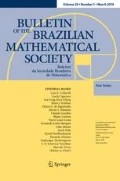Abstract.
V.A. Rohlin asked in 1949 whether 2-fold mixing implies 3-fold mixing for a stationary process (ξ i )i2ℤ, and the question remains open today. In 1978, F. Ledrappier exhibited a counterexample to the 2-fold mixing implies 3-fold mixing problem, the socalled 3-dot system, but in the context of stationary random fields indexed by ℤ2.
In this work, we first present an attempt to adapt Ledrappier's construction to the onedimensional case, which finally leads to a stationary process which is 2-fold but not 3-fold mixing conditionally to the σ-algebra generated by some factor process. Then, using arguments coming from the theory of joinings, we will give some strong obstacles proving that Ledrappier's counterexample can not be fully adapted to one-dimensional stationary processes.
Similar content being viewed by others
Author information
Authors and Affiliations
Corresponding author
About this article
Cite this article
de la Rue, T. 2-fold and 3-fold mixing: why 3-dot-type counterexamples are impossible in one dimension. Bull Braz Math Soc, New Series 37, 503–521 (2006). https://doi.org/10.1007/s00574-006-0024-z
Received:
Issue Date:
DOI: https://doi.org/10.1007/s00574-006-0024-z




